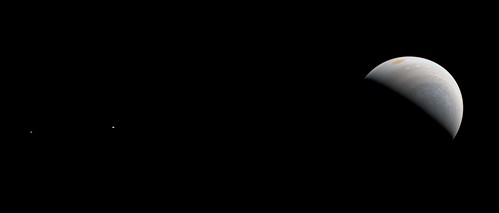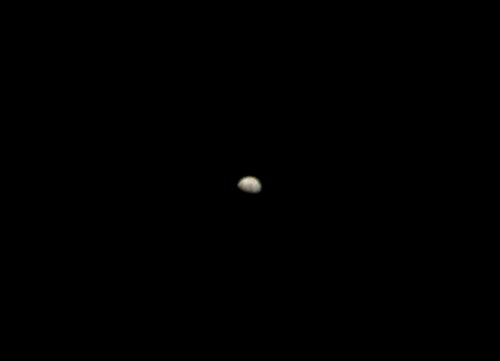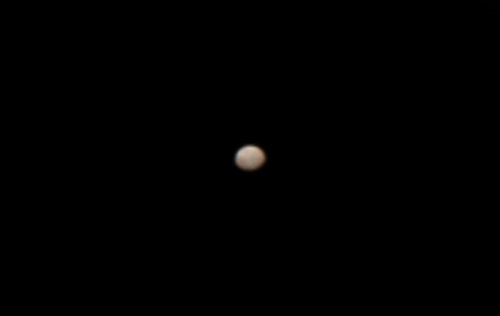It's time to start a new topic for Juno's Perijove-09.
Due to solar conjunction, data downlink is delayed several days, but things appear to look good thus far.
Data downlink started on October 31, and if everything continues well, it should be a matter of a few days, at most, until the majority of the raw Perijove-09 images will become available. Due to the incremented available storage for JunoCam, we may get a sufficient coverage to render a pole to pole -- well, almost pole to pole -- fly-over reconstruction, despite the difficult communication near solar conjunction. I'll have a try at least, over the next few weeks.
Full Version: Juno perijove 9
More power to you Gerald, next week is going to be busy & fun!
The PJ9 images are on missionjuno (although the front page doesn't say this yet.)
PJ-09, quick & dirty version without SPICE nor shape model, therefore close-up portions not yet properly RGB aligned.
The enhanced versions will take another few hours.
The enhanced versions will take another few hours.
This is the 10-fold reduced testrun of the version I'm currently rendering:
Click to view attachment
Click to view attachment
Gerald, thanks for making the quick and dirty versions available so quickly. I have processed image #105, which is a family portrait of Jupiter with Io and Europa.

Perijove 9 Departure - JunoCam
A small amount of unsharp masking was applied to enhance some of the detail, which reveals what look like real albedo features on Io's surface. This image is simply enlarged by 3x:

Ganymede Perijove 9 detail - JunoCam
This is Io's southern hemisphere but I'm not entirely sure which features should be visible. Maybe Tarsus Regio?

Perijove 9 Departure - JunoCam
A small amount of unsharp masking was applied to enhance some of the detail, which reveals what look like real albedo features on Io's surface. This image is simply enlarged by 3x:

Ganymede Perijove 9 detail - JunoCam
This is Io's southern hemisphere but I'm not entirely sure which features should be visible. Maybe Tarsus Regio?
Great to see you finding out which moons those are, while I've been rendering and uploading the enhanced versions of the close-ups to the missionjuno site. 
Here the JPG version, going to be distributed over several posts:
Perijove-09, #75, #76, #79, and #79:
Click to view attachment Click to view attachment
Click to view attachment Click to view attachment
As usual since Juno has been orbiting Jupiter, the close-ups start with images of the north polar region.
Here the JPG version, going to be distributed over several posts:
Perijove-09, #75, #76, #79, and #79:
Click to view attachment Click to view attachment
Click to view attachment Click to view attachment
As usual since Juno has been orbiting Jupiter, the close-ups start with images of the north polar region.
PJ-09, #80, and #81, with close-ups of the northern "folded filamentary regions" (FFRs), mostly cyclonic turbulent storms known for their increased probability to show lightnings:
Click to view attachment Click to view attachment
Click to view attachment Click to view attachment
#88, and #89, now we are already above the southern hemisphere:
Click to view attachment Click to view attachment
Click to view attachment Click to view attachment
#90, with the white anticyclonic oval A5, if the prognosis has been correct:
Click to view attachment
Click to view attachment
Approaching the south pole along images #93, #94, #95:
Click to view attachment Click to view attachment Click to view attachment
The transition into the departure sequence with images
#97 and #98, and with some gap the slightly overexposed #105:
Click to view attachment Click to view attachment Click to view attachment
Image #105 shows some artifacts near the GRS induced by my patching algorithm for camera artifacts. The algorithm uses nearby colors to fill in invalidated regions, which works pretty well in most cases, but not near the GRS.
Click to view attachment Click to view attachment Click to view attachment
The transition into the departure sequence with images
#97 and #98, and with some gap the slightly overexposed #105:
Click to view attachment Click to view attachment Click to view attachment
Image #105 shows some artifacts near the GRS induced by my patching algorithm for camera artifacts. The algorithm uses nearby colors to fill in invalidated regions, which works pretty well in most cases, but not near the GRS.
Striving towards an enhanced but still naturalistic processed version. This is my take on #084, which includes a photobomb by Io and Europa.

Southern Hemisphere - JunoCam
A very close look at Io shows a circular reddish spot at about the 9 o'clock position. There are some subtle albedo features around the 2 o'clock position as well. My guess (and this is only a guess), is that they are the Pele plume deposits and the region around Issum Patera, respectively. Here's a 4x enlarged image. (To view the uncompressed image, click through and add '/sizes/o' to the end of the url)

Io - JunoCam

Southern Hemisphere - JunoCam
A very close look at Io shows a circular reddish spot at about the 9 o'clock position. There are some subtle albedo features around the 2 o'clock position as well. My guess (and this is only a guess), is that they are the Pele plume deposits and the region around Issum Patera, respectively. Here's a 4x enlarged image. (To view the uncompressed image, click through and add '/sizes/o' to the end of the url)

Io - JunoCam
Perijove-09 inbound RGB images, reprojected, and enhanced. Illumination adjustment is based on PJ-06 TDI-2 images, and may be biased.
I'm elaborating approach and some departure PJ-09 images in more detail, since they are likely to be the only visible light Jupiter images of a major part of its surface available during solar conjunction.
Departure images are more challenging to process due to spacecraft maneuvers, and due to the position of Jupiter approaching the left margin of JunoCam's fov, where geometric calibration is particularly tricky. I'll see over the next few days, how far I can get, hopefully over the first two Jupiter days (i.e. 20 hours) after PJ-09, at least.
I might find time to infer a PJ-09 specific illumination model before PJ-10, but I'm not yet sure.
I'm elaborating approach and some departure PJ-09 images in more detail, since they are likely to be the only visible light Jupiter images of a major part of its surface available during solar conjunction.
Departure images are more challenging to process due to spacecraft maneuvers, and due to the position of Jupiter approaching the left margin of JunoCam's fov, where geometric calibration is particularly tricky. I'll see over the next few days, how far I can get, hopefully over the first two Jupiter days (i.e. 20 hours) after PJ-09, at least.
I might find time to infer a PJ-09 specific illumination model before PJ-10, but I'm not yet sure.
These pictures are convincing me that there will eventually be enormous scientific payoff from the Juno imagery, despite the official disclaimers. The still images alone speak to the dynamics taking place, and in concert with the deep-looking radiometry and lower-resolution images from Earth that provide greater temporal coverage, seemingly must speak volumes to the atmospheric dynamics at large and small scales.
And also: They are stunning! You amateur image wizards are working wonders.
And also: They are stunning! You amateur image wizards are working wonders.
The Atlantic posted an article today by Marina Karen titled The Photoshoppers Behind Dreamy Jupiter Photos, which quotes members Gerald Eichstädt, Seán Doran, Björn Jónsson, Roman Tkachenko, Emily Lakdawalla, and Jason Major (listed in the order mentioned).
https://www.theatlantic.com/science/archive...ictures/546146/
The article includes a passage that echoes JRehling's observation about the scientific value of these images:
https://www.theatlantic.com/science/archive...ictures/546146/
The article includes a passage that echoes JRehling's observation about the scientific value of these images:
QUOTE
JunoCam wasn’t designed for scientific purposes—its sole mission is, quite literally, to take pretty pictures—but the Juno team has used the images to better understand the meteorology of gas giants, in our solar system and beyond. “Jupiter can be considered as representing a population of gas giants, likely a widespread population of celestial bodies in the observable universe,” Eichstädt said. “Understanding Jupiter means understanding non-negligible portions of our universe.”
Here is a montage of several versions of PJ-9 image 93:
Click to view attachment
A: An approximately true color/contrast image.
B: An approximately true color/contrast image where the effects of global illumination have been removed. This reveals dimly lit features near the terminator.
C: Same as B but in addition, the colors and contrast have been exaggerated and small scale details sharpened to better reveal various features.
D: Same as the previous version with the addition of a latitude/longitude grid. This reveals the location of Jupiter's south pole.
A subset of the metadata:
IMAGE_TIME = 2017-10-24T18:39:10.279
MISSION_PHASE_NAME = PERIJOVE 9
PRODUCT_ID = JNCE_2017297_09C00093_V01
SPACECRAFT_ALTITUDE = 79834.2 km
SPACECRAFT_NAME = JUNO
SUB_SPACECRAFT_LATITUDE = -78.1351
SUB_SPACECRAFT_LONGITUDE = 279.7929
TITLE = Southern timelapse
Resolution at nadir: ~54 km/pixel
Click to view attachment
A: An approximately true color/contrast image.
B: An approximately true color/contrast image where the effects of global illumination have been removed. This reveals dimly lit features near the terminator.
C: Same as B but in addition, the colors and contrast have been exaggerated and small scale details sharpened to better reveal various features.
D: Same as the previous version with the addition of a latitude/longitude grid. This reveals the location of Jupiter's south pole.
A subset of the metadata:
IMAGE_TIME = 2017-10-24T18:39:10.279
MISSION_PHASE_NAME = PERIJOVE 9
PRODUCT_ID = JNCE_2017297_09C00093_V01
SPACECRAFT_ALTITUDE = 79834.2 km
SPACECRAFT_NAME = JUNO
SUB_SPACECRAFT_LATITUDE = -78.1351
SUB_SPACECRAFT_LONGITUDE = 279.7929
TITLE = Southern timelapse
Resolution at nadir: ~54 km/pixel
At the edge of the abyss (Jupiter at 4467 km)


My JunoCam workflow still isn't 100% satisfactory, but was able to work these up over the weekend after realizing I had nothing good from Perijove 9. I'm using a script which simply grabs each strip and stacks them by color band. It doesn't yet do any spice-based alignment or reprojection, but I'm hopeful I can figure that part out. The script also does a histogram equalization and grayscale contrast adjust. I take the output into Photoshop, do some manual alignment, brightness adjustment, and sometimes a HDR toning for contrast and structure. Finally, I make final adjustments for tone, presence, sharpening, & noise in Lightroom.
A couple more shots I was able to go back and reprocess. The color isn't quite there and I am focusing on enhanced contrast.
Io as seen by Juno


A couple more from various points in the mission
In the meanwhile, John Rogers released two reports about Perijove-09:
Juno at Perijove-9 (Part I): Global maps, and
Juno at Perijove-9 (Part II): What the close-up images show.
Despite the difficult observational conditions, we were able to create a global cylindrical map.
Of particular interest is a newly formed south tropical disturbance near the GRS.
Juno at Perijove-9 (Part I): Global maps, and
Juno at Perijove-9 (Part II): What the close-up images show.
Despite the difficult observational conditions, we were able to create a global cylindrical map.
Of particular interest is a newly formed south tropical disturbance near the GRS.
The Atlantic posted an article today by Marina Karen titled The Photoshoppers Behind Dreamy Jupiter Photos, which quotes members Gerald Eichstädt, Seán Doran, Björn Jónsson, Roman Tkachenko, Emily Lakdawalla, and Jason Major (listed in the order mentioned).
https://www.theatlantic.com/science/archive...ictures/546146/
https://www.theatlantic.com/science/archive...ictures/546146/
A bit belated, but congratulations to you all for this article and recognition! The Atlantic is a widely-distributed US magazine. The article also name-checks our 'no-frills' Forum.
Well, UMSF has been playing an important, if not essential role in bringing people together. 
---
Here a link to a Perijove-09 flyby animation.
The link is submitted to missionjuo, too.
I've implemented a "nadir mode" for cylindrical views. This helps to make the movie's horizontal center continuously pointing to Jupiter's center. Vertical displacement is allowed in order to fit with JunoCam's fov. For the youtube version of the movie, I've chosen half second blendings, since the alignment of the scenes isn't quite perfect, and would hence result in doubled features over too long periods of time.
I'll try to upload stills, and mp4 files onto the junocam.pictures webspace later tonight (CET).
---
Here a link to a Perijove-09 flyby animation.
The link is submitted to missionjuo, too.
I've implemented a "nadir mode" for cylindrical views. This helps to make the movie's horizontal center continuously pointing to Jupiter's center. Vertical displacement is allowed in order to fit with JunoCam's fov. For the youtube version of the movie, I've chosen half second blendings, since the alignment of the scenes isn't quite perfect, and would hence result in doubled features over too long periods of time.
I'll try to upload stills, and mp4 files onto the junocam.pictures webspace later tonight (CET).
Another excellent effort Gerald! I think this sequence really sells how close Juno gets to Jupiter. I hope the tweening software can handle the closer frames without too much trouble.
This is so cool Gerald! Here is my humble attempt at a more poetic rendering of your animation:
https://vimeo.com/244473772
https://vimeo.com/244473772
Thanks! I like that sound track of Vangelis, Avisolo.
The stills are online since a few hours; the online version is compressed to 1.7 GB of JPG files, I've used 98% quality in order to save upload time and storage volume, and to maintain good quality.
I've rendered two movie versions, one with short blending for Youtube upload, and another one with long blending resulting in an overall more continuous impression, but with considerable feature doubling.
The individual scenes before blending are provided as MP4, as well.
The MP4 scenes have been rendered from BMP files, the same files the JPG stills are derived from. Each of the BMP files has been rendered directly from the respective raw files in one monolithic step using double precision floating point arithmetics.
The stills are online since a few hours; the online version is compressed to 1.7 GB of JPG files, I've used 98% quality in order to save upload time and storage volume, and to maintain good quality.
I've rendered two movie versions, one with short blending for Youtube upload, and another one with long blending resulting in an overall more continuous impression, but with considerable feature doubling.
The individual scenes before blending are provided as MP4, as well.
The MP4 scenes have been rendered from BMP files, the same files the JPG stills are derived from. Each of the BMP files has been rendered directly from the respective raw files in one monolithic step using double precision floating point arithmetics.
Thanks Gerald!
I've replaced the original video with the files you uploaded, makes for better viewing:
https://vimeo.com/244473772
I've replaced the original video with the files you uploaded, makes for better viewing:
https://vimeo.com/244473772
Beautiful! I've recommended it via email to several members of the JunoCam team.
It appears that these animation renders are reversed/mirrored. Can you confirm this Gerald? At least when compared with the initial processed stills.
You are right, the cyclones are winded in the wrong sense. I should have noticed that. I'll try to mirror the movie. The stills will remain as they are.
It's easy enough to correct, I just wanted to make sure you knew.
These things can happen, especially when I'm working around the clock. Thanks for your checking!
The flip-corrected version is on Youtube, now.
The previous version on the missionjuno site hasn't been approved yet. So, I've removed it and added the revised version, instead.
The flip-corrected version is on Youtube, now.
The previous version on the missionjuno site hasn't been approved yet. So, I've removed it and added the revised version, instead.
Here is an early pass on Gerald's video [flipped, rotated, variably retimed & processed] set to 'Orphic Hymn' by Jóhann Jóhannsson

60fps version on Youtube

60fps version on Youtube
Amazing planet and excellent work from Sean and Gerald. I'm gradually getting better at figuring which belts/zones we are seeing when we're at somewhat lower latitudes. Post #31 helps with this.
Walnut? or birds eye Maple perhaps, nah, too dark, which brings me onto that!!! couch....
The slightly fuzzy, wrapped canvas isn't too bad though.
The slightly fuzzy, wrapped canvas isn't too bad though.
Haha... thanks Doug, I love coffee coming out of my nose!
This is a "lo-fi" version of our main content. To view the full version with more information, formatting and images, please click here.

































